15 Flowers & Plants That Attract Hummingbirds (With Pictures)
-
Pete Ortiz
- Last updated:

Hummingbirds aren’t only beautiful and fun to have around. They’re also big helpers in the garden. First, the hummers feed on the pests, keeping your plants safe. Second, they are natural pollinators. Without them, you’ll have a hard time running a garden. That’s why these birds are always welcome in the backyard. So, the big question is—how do you attract hummingbirds?
Well, since they only eat two things, insects and nectar, it all comes down to having the right plants on the property. And we have just the right picks for you today! Join us, and let’s talk about the biggest “magnets” for hummingbirds. To make navigation easier, we broke the list into perennials, annuals, and vines.
The 15 Flowers & Plants That Attract Hummingbirds
Perennials
It’s no secret that perennials are a bit slow to grow. But, when taken care of properly, they do come back next year. There are hundreds of native perennials in the US. The following list includes the flowers and plants that attract hummingbirds and smell really good. Check them out!
1. Cardinal Flower

| Botanical Name: | Lobelia cardinalis |
| Available Colors: | White, scarlet red, rose |
| Soil Type: | Well-drained, moist/wet, moderately rich, 5.5–7.0 |
| Sun Exposure: | Full sun/partial shade |
| Hardiness Zone: | 2–9 USDA |
The cardinal flower reaches six feet in height and produces five-lobed red blooms that instantly grab the attention of hummingbirds. Just like bees and butterflies, they feed on the nectar while pollinating it. To ensure steady growth, make sure the soil is not only well-drained but also slightly wet and rich. Full sun is preferred, yet the cardinal flower can flourish in shade as well.
The best spots to grow this flower are native gardens and borders. Sadly, it only stays in bloom for 2–3 weeks. On the bright side, this is a self-rooting plant.
2. Bee Balm

| Botanical Name: | Monarda didyma |
| Available Colors: | Red, orange, purple |
| Soil Type: | Well-drained, evenly moist, rich, 6.0–6.7 |
| Sun Exposure: | Full sun |
| Hardiness Zone: | 4–9 USDA |
The spherical, spiky shape and the bright colors make the bee balms stand out. They grow best in full sun and prefer moist and moderately rich soil. Much like the cardinal flowers, they are very hard to miss. However, bee balms aren’t very tall (2–4 inches in height). To compensate for that, the average lifespan is more than decent, and the blooms can last for up to two months (in summer/early fall).
3. Bleeding Heart
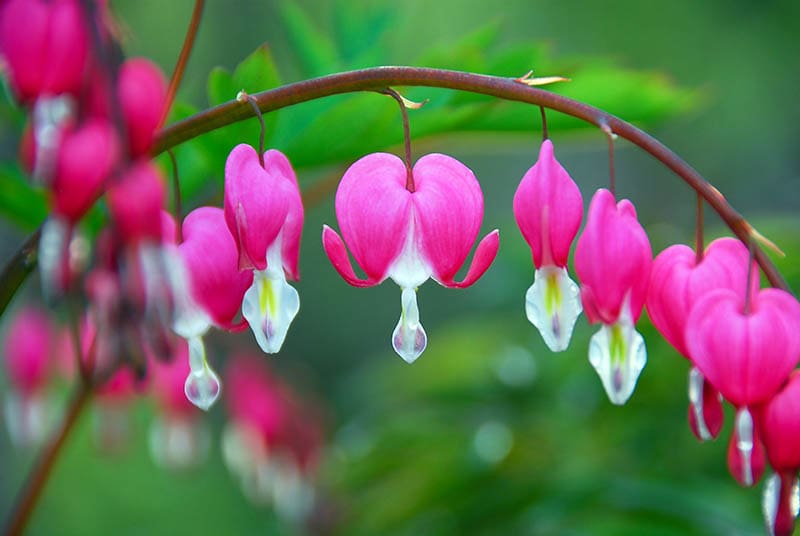
| Botanical Name: | Lamprocapnos spectabilis |
| Available Colors: | Pink, red, yellow, violet |
| Soil Type: | Well-drained, moist, fertilized, organic, 6.0–6.5 |
| Sun Exposure: | Sun/light shade |
| Hardiness Zone: | 2–9 USDA |
The bleeding heart is one of the most beautiful flowers on the planet. The blooms are rich in nectar, look like tiny hearts, and dangle from the foliage. They can be red, yellow, violet, or pink. For most birds, it’s hard to reach the nectar hidden in these blooms, but not for hummingbirds! To stimulate growth, plant the flowers in a cool and shaded area.
They’ll flourish in early spring and die in mid-summer. Go with well-drained, moist, and organic soil.
4. Beardtongue

| Botanical Name: | Penstemon |
| Available Colors: | Red, orange, blue, purple |
| Soil Type: | Well-drained, rich, 5.5–7.0 |
| Sun Exposure: | Full sun |
| Hardiness Zone: | 3–8 USDA |
Native to North America, beardtongue flowers are mostly red and orange but can also be purple or blue. They come in many different forms, too, depending on the area. If you’re looking for a low-maintenance plant for hummingbirds, these will be a great pick. As long as the flowers get 6–8 hours of sun and grow in well-drained, organically rich soil, they will thrive.
The tubular blooms and tall spikes look stunning in May through October, reach four feet in height, and easily “cut through” most weeds.
5. Columbine
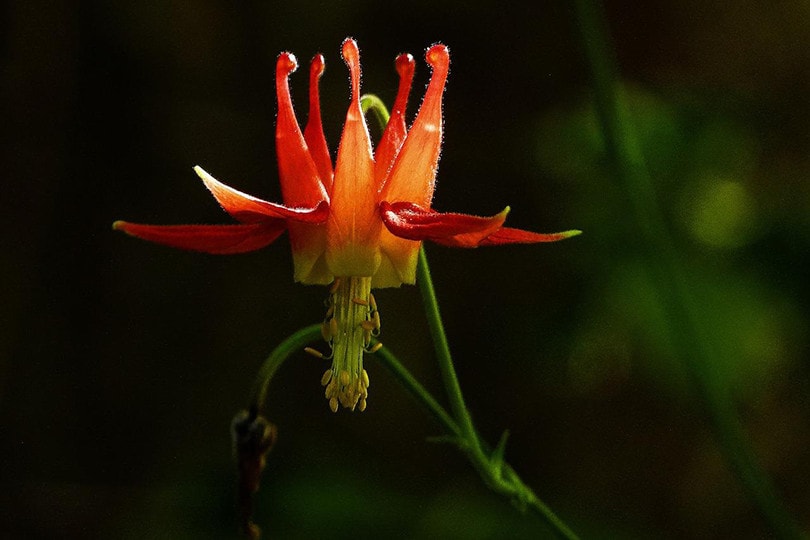
| Botanical Name: | Aquilegia |
| Available Colors: | Pink, purple, red, blue |
| Soil Type: | Well-drained, humus-rich, sandy, loamy, 6.0–8.0 |
| Sun Exposure: | Full sun/partial shade |
| Hardiness Zone: | 3–8 USDA |
It’s hard to tell how many variants of the Columbine flower there are. But one thing is certain: native species are best for luring hummingbirds in. For example, the Eastern Red Columbine looks absolutely gorgeous when it blossoms and attracts hummers with red, pink, or purple blooms. More importantly, its nectar is almost two times sweeter compared to other species.
Columbine is an early-spring plant and is often used for edging around fences. It flourishes in humus-rich and loamy sand.
6. Catmint
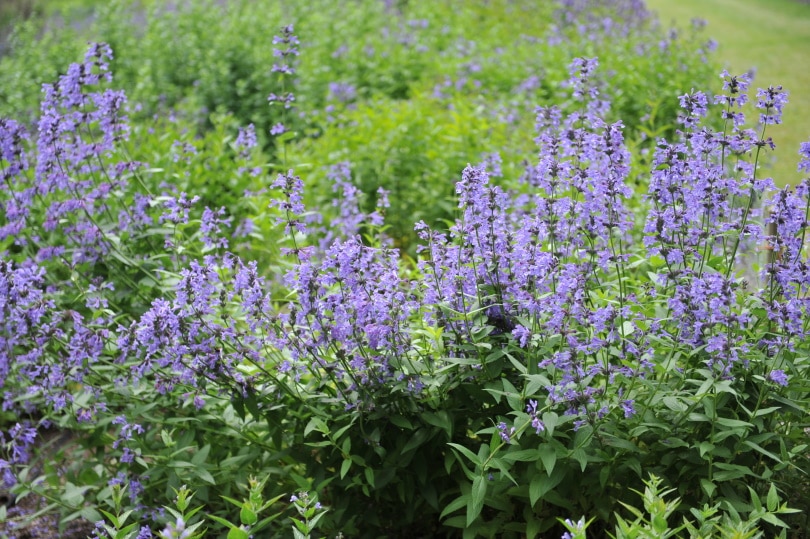
| Botanical Name: | Nepeta |
| Available Colors: | Purple, white, blue |
| Soil Type: | Well-drained, rocky, clay, 5.0–8.0 |
| Sun Exposure: | Full sun/partial shade |
| Hardiness Zone: | 3–9 USDA |
Are you in the market for a long-blooming, low-effort, and quick-to-spread plant? Then catmints will be right up your alley. They are highly resistant to pests and can survive in zones 3 to 9. As for the soil, these flowers will grow even in rocky terrain as long as the soil is well-drained. For hummingbirds, go with the Siberian catmint. Its blue blossoms are a tasty snack for these birds.
This catmint has a fresh, minty smell. On the downside, it’s an aggressive grower.
7. Giant Hyssops
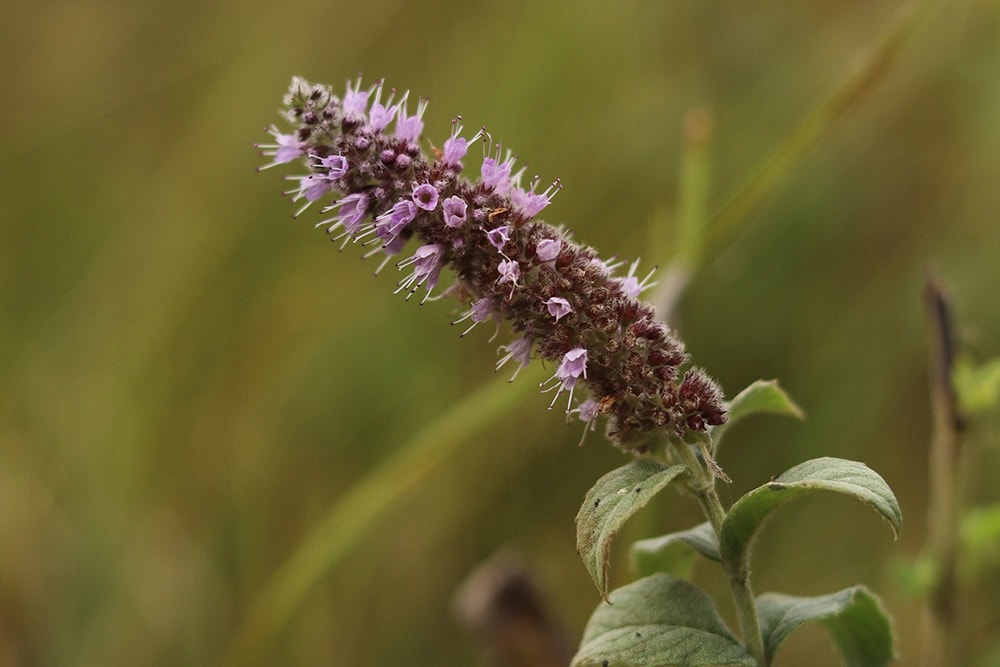
| Botanical Name: | Agastache urticifolia |
| Available Colors: | Red, pink, violet-blue, white |
| Soil Type: | Well-drained, loamy, sandy, poor, 6.5–8.5 |
| Sun Exposure: | Full sun/partial shade |
| Hardiness Zone: | 8–10 USDA |
Often called the hummingbird mint, the Agastache family of flowers is widespread across the country. And the hummingbirds are especially fond of the giant hyssops. These plants grow equally well in full sun and shade but won’t survive in the cold. The blooms grow on thin, tall stalks and come in different shapes and sizes, with pink, violet, and red being the prevalent colors.
8. Larkspurs

| Botanical Name: | Delphinium |
| Available Colors: | Blue, red, violet, white |
| Soil Type: | Well-drained, moist, humus-rich, 6.5–7.0 |
| Sun Exposure: | Full sun |
| Hardiness Zone: | 3–8 USDA |
With larkspurs, you won’t have to worry about the garden running out of nectars. The delphinium plants (dolphin in Greek) have more than enough both for hummingbirds and other birds/bugs. Each step has dozens of flowers that can feed an army of pollinators. Larkspurs bloom in May–June and look stunning in blue.
With an average height of 2–8 feet, they grow better in colder climates. Full sun is preferred, though.
Annuals
Hummingbirds are big fans of annuals. First, these flowers/plants are rich in nectar. Second, they bloom in abundance. And if you plant various annuals in the yard that flower at different times of the year, hummingbirds will always have something to feed on. Here are our top picks:
9. Flowering Tobacco
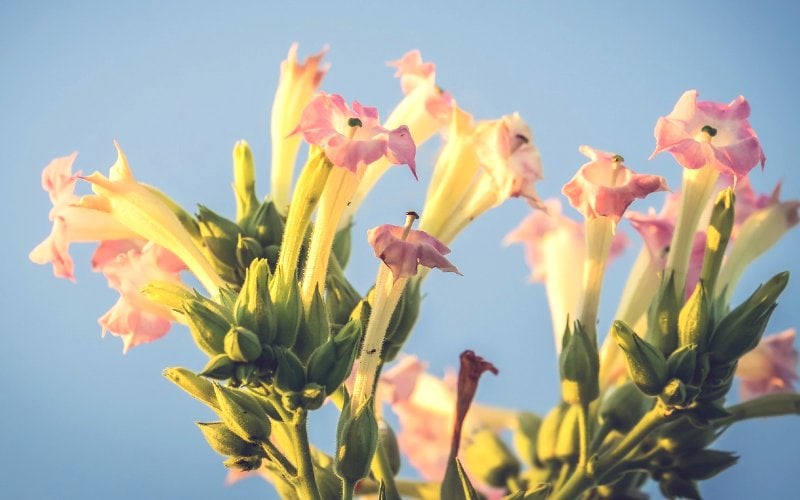
| Botanical Name: | Nicotiana alata |
| Available Colors: | Red, pink, purple, blue, green |
| Soil Type: | Well-drained, moist, organically rich, 6.1–7.8 |
| Sun Exposure: | Full sun/partial shade |
| Hardiness Zone: | 10–11 USDA |
And what does this plant have to offer? Well, it’s not at all hardy and only survives in hot climates (10–11 USDA). Next, it needs the soil to be rich in nutrients and moist to grow properly. The flowering tobacco doesn’t last that long, either. At the same time, it has a delicious smell and is perfect as an ornamental plant.
The number of available colors is quite impressive as well and includes green, blue, purple, and red, to name a few.
10. Salvia
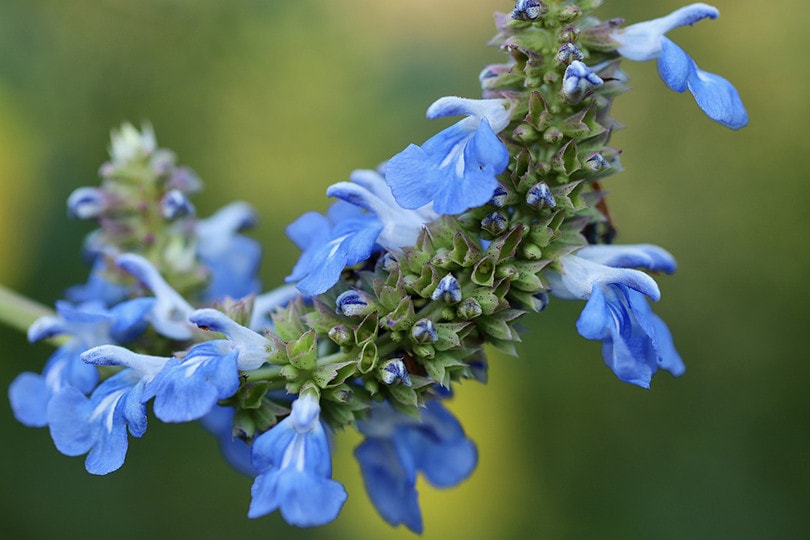
| Botanical Name: | Salvia spp. |
| Available Colors: | Purple, pink, blue, mauve |
| Soil Type: | Well-drained, moist, poor, 5.5–6.5 |
| Sun Exposure: | Full sun/partial shade |
| Hardiness Zone: | 4–11 USDA |
Many gardeners swear by Salvias because of their beauty, health benefits, and flexible nature. They belong to the Sage family and are the ultimate choice for attracting hummingbirds. The tubular blooms are perfect for their long beaks. These plants are hardy to zones 4 to 11 and are equally resistant to mild cold and excessive heat.
In addition, they are easily recognizable thanks to the tall spikes. Salvias blossom in mid-summer and last through most of August.
11. Petunias

| Botanical Name: | Petunia |
| Available Colors: | Red, blue, white, pink, purple |
| Soil Type: | Well-drained, moist, moderately fertilized, 6.0–7.0 |
| Sun Exposure: | Full sun |
| Hardiness Zone: | 10–11 USDA |
If you’re looking for potted flowers that attract hummingbirds, petunias will be a great pick. They grow equally well in containers, pots, and baskets. For maximum growth, plant them in moist, well-drained, and fertilized soil. The one thing to keep in mind is that petunias can’t tolerate low temps. So, move them indoors when the cold days arrive.
They are easy to grow—that’s what makes these lovely plants so popular. Also, they bloom non-stop, keeping the nectar levels high.
12. Zinnia
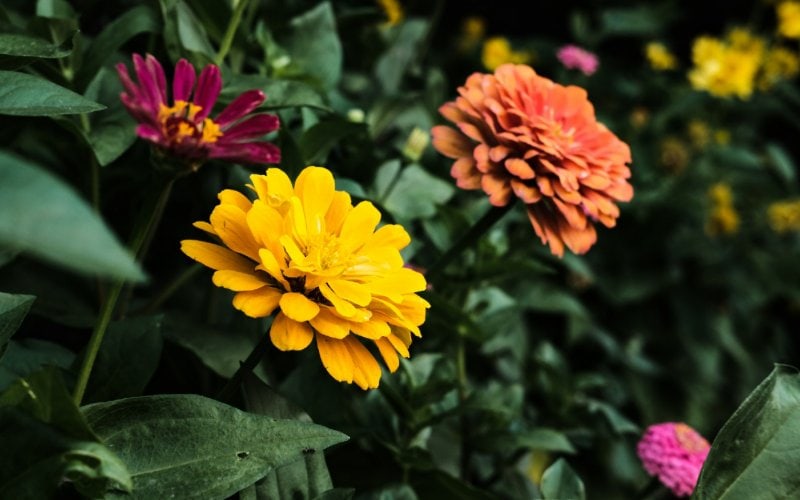
| Botanical Name: | Zinnia spp. |
| Available Colors: | Red, orange, yellow, pink, white |
| Soil Type: | Well-drained, organically rich, 5.5–7.5 |
| Sun Exposure: | Full sun/partial shade |
| Hardiness Zone: | 2–11 USDA |
Just like petunias, zinnias take minimal effort to grow in one’s backyard. You just sow the seeds, and they turn into beautiful flowers! Full sun or shade and rich, well-drained soil are the keys to success here. Zinnias are praised for their impressive “temperature range”: they cover hardiness zones from 2 (really cold) to 11 (very hot).
The plants reach four feet in height but can be as small as six inches. As for the blooms, they are truly fabulous, especially in red and pink.
13. Lupine

| Botanical Name: | Lupinus |
| Available Colors: | White, blue, pink, purple |
| Soil Type: | Well-drained, moist, loamy, 5.8–7.2 |
| Sun Exposure: | Full sun |
| Hardiness Zone: | 3–8 USDA |
Hummingbird fans looking for early-to-bloom flowers for the spring will find much value in these plants. The wild lupines aren’t built for home gardens, but the hybrid species are an entirely different story. With an average size of 2–4 feet, lupines grow best in loamy and moist soil with full exposure to the sun.
Vines
If you like growing vines in the garden, we’re happy to say that hummingbirds will appreciate your efforts. The higher the vines, the easier it will be for the birds to notice them from afar. These plants do take a bit more effort to grow, but they’re well worth it.
14. Trumpet Creeper/Wine
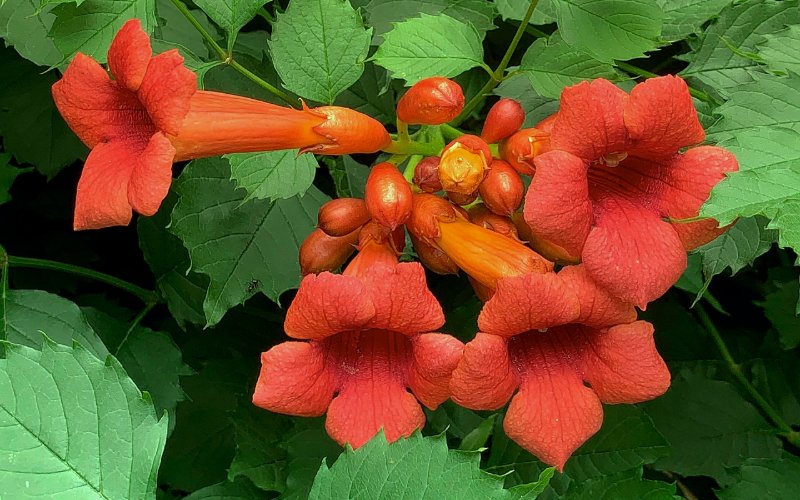
| Botanical Name: | Campsis radicans |
| Available Colors: | Red, orange, yellow |
| Soil Type: | Well-drained, sandy, loamy, rich, 3.7–6.8 |
| Sun Exposure: | Full sun/partial shade |
| Hardiness Zone: | 4–10 USDA |
Known in most parts of the country as the hummingbird vine, the trumpet creeper is a go-to plant for attracting hummers. It’s quick to climb up trellises, fences, trees, and fellow flowers. The foliage is rather dense, while the flowers have a tubular shape. That makes it easier for hummingbirds to reach the nectar. To slow down the growth, master the art of frequent pruning. Otherwise, the garden will be taken over by these creepers!
15. Trumpet/Coral Honeysuckle

| Botanical Name: | Lonicera sempervirens |
| Available Colors: | Red, orange, yellow |
| Soil Type: | Well-drained, loamy, rich, 5.5–8.0 |
| Sun Exposure: | Full sun/partial shade |
| Hardiness Zone: | 4–10 USDA |
Just like the trumpet creeper, the trumpet honeysuckle is an aggressive plant that grows best when climbing a lattice. And it draws hummingbirds in with the red, orange, or yellow blossoms during the hot summer days. The blooming goes on for the whole season, which can’t be said about most flowers on the list. This is a low-maintenance plant that’s only attacked by aphids.
Getting the Garden Ready for Hummingbirds
Now that we’ve made it through the list, here’s a quick look at some tried and true tricks for attracting hummingbirds:
- Create gaps between the plants. When there’s limited space between the flowers, this makes it harder for hummingbirds to feed on the nectar. On average, 1–2 feet of distance should be more than enough.
- Go with bright colors. Did you know that hummingbirds use colors when navigating? That’s right! The most attractive color for these birdies is red. Orange, yellow, and pink also catch their attention.
- Provide a steady water source. Like most birds out there, hummingbirds take quick baths to clean their wings. A fountain or sprinkler hose will serve as a magnet for the hummers.
- Don’t remove spider webs. Our first instinct is to get rid of any webs we see. But, do remember that hummingbirds use webs to build their nests and often eat the bugs that are trapped there.
Quick Facts About Hummingbirds
- Hummingbirds are tiny and lightweight. The average weight of such a bird is 0.15 ounces. Most species are 2–5 inches in length. Bee hummingbirds are the smallest ones (2 inches, 0.07 ounces).
- They can fly in any direction they want, including backward. This is made possible thanks to the incredible speed at which their wings move: 10–80 beats per second!
- The heart rate of a hummer can be as slow as 50–180 beats or as fast as 1,260 beats per minute, depending on the outside temperature.
- To refill their energy reserves, hummingbirds eat half of their own weight per day. The diet includes nectar and insects.
Conclusion
Hummingbirds are truly fascinating. They’re fast, resilient, and can “cover” up to a thousand flowers per day. Hummers don’t ravish the leaves, ruin the roots, or damage the crops. Instead, these birds feed on aphids, wasps, mosquitoes, and beetles, keeping the garden healthy. Hummingbirds are great pollinators, too, and help with the fertilization of various plants.
And you don’t need to do much work in the backyard to attract hummers. All that’s required here is to know which flowers, herbs, or vines they’re naturally drawn to and sow them in the garden. That’s it! So, pick a plant from our list, make sure it can handle your climate and wait for the hummingbirds to arrive!
See also:
- How Often Should You Change a Hummingbird Feeder? Factors, Steps & FAQs
- 10 DIY Hummingbird House Plans You Can Build Today (With Pictures)
- Animals.Mom.Com – Weight of a Hummingbird
- NationalParkService.Gov – Hummingbirds
- How much does a Hummingbird Eat?
- BrandyWine.Com – Attracting Hummingbirds
- Mesa.WBU – Fun Facts About Hummingbirds
- Hort.Extension.Edu – Cardinal Flower
- Brecks.Com – How to Grow & Care for Bee Balm Plants
- US.ForrestService.Gov – Red Columbines
- Gardenia.Net – Nepeta Sibirica (Catmint)
- Growing Nicotiana To Attract Hummingbirds
- NCExtension.Edu – Delphinium carolinianum
- NIH.Gov – Salvia Cognitive-Enhancing Effects
- Zinnias: The Hardest-Working Flower in the Garden
- Gardenia.Net – Trumpet Honeysuckle
Featured Image Credit: Dustin Humes, Unsplash
Contents



